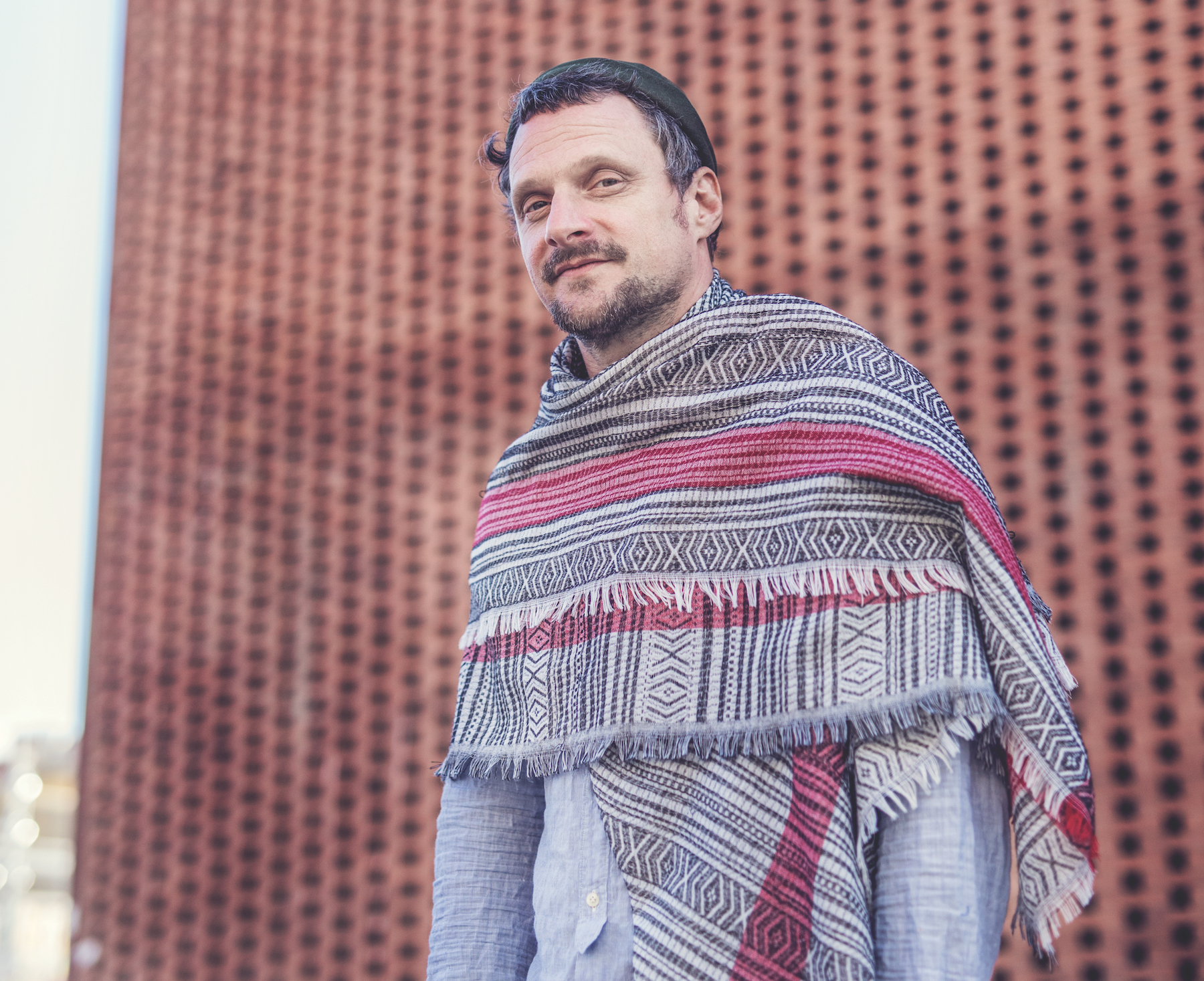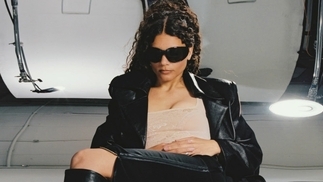DJ Koze: DJ Mag UK Cover Feature

Stefan Kozalla is many things to many people: co-owner of an acclaimed label, production enigma and true free spirit. DJ Mag caught up with him in Barcelona ahead of his ace new album ‘Knock, Knock’ to discover that nothing is bigger than the idea, and how the creative balancing act can take its toll...
It makes sense that DJ Mag has landed in Barcelona to meet DJ Koze. It’s a city where the abstract and traditional happily co-exist, where snake-like, meandering streets flow into strict, rigid grids and modernist architecture complements classic design. A symbol of independence for many, it’s a place constantly under construction, where cranes loom over half-finished concepts and where individualism is celebrated at every turn, with parks and museums dedicated to experimental icons.
The Pampa Records owner is waiting for us in a Las Ramblas hotel. It’s a bright day in the city, with a freshness still lingering from the cold spell that’s just hit Europe. As we crawl along the motorway in rush hour traffic, DJ Mag is told to meet on the roof of the hotel, where Koze’s cover shoot is well underway.
Climbing the staircase to the hotel’s highest point, we round the corner to see Stefan Kozalla standing on a chair, leaning into the camera lens, palms pressed together. Behind him, an angry grey cloud splits the blue backdrop, and Koze is adamant we act quickly to capture the exceptional skyline. It’s only when the light fades again that he breaks character to welcome DJ Mag to the rooftop, before running to his bag, giddily shifting through like a child playing dress up.

Koze has a reputation as an obscure and abstract artist, one he’s earned over his 30-year career. Often intentionally distorting reality, a wry sense of humour fuels his work, with album covers and music videos reflecting his music’s leftfield nature. It’s no gimmick – while his personality cuts through everything he does, it complements rather than defines his work. As we’ll learn, Koze takes his art very seriously, often at his own expense.
We’re in town to talk about his new album, his first in five years. ‘Knock Knock’’s 16 tracks cover Koze’s myriad of influences and styles, featuring guests as diverse as Roisín Murphy, Lambchop’s Kurt Wager, Caribou and Arrested Development’s Speech. His trademark textures and melodies intertwine to create a melancholic but hopeful record, easily one of his best works, and one that will no doubt be in the albums-of-the-year conversation. From the opener ‘Club Der Ewgkeiten’, Koze’s sense of tension and release is established early, as an edgy sample reminiscent of film composer Bernard Herrmann’s work gives way to a lush open chorus of flutes and strings. Koze’s relationship with tension and release, we’ll soon find out, goes a long way to defining him as an artist.
DMC XTC
While the DJ Koze moniker has only been in use since 2000, Kozalla’s relationship with electronic music goes back much further. Starting out as a talented turntablist, coming second in Germany’s DMC Championship at the age of 16, his first love was hip-hop. Taking home the silver medal is something that’s always “kept me hungry”, he says with a wry smile.
“When I came second, I thought, ‘Now I’m on fire’. Turntablism was really huge during this period, the DMC championships actually took place at the Royal Albert Hall for the World Finals, with Qbert and DJ Reckless and all these big names from that time, around 1988. It was a period where people were really showing off. The guy who won did a handstand on the turntable, while mixing with the other hand. It was really showy. Now it’s more about being technical.”
In 1993 he formed Fischmob, a popular German hip-hop and electronic group out of Hamburg. The video for their 1994 hit ‘Bonanzarad’ shows the early signs of Koze’s more eccentric inclinations, with the long-haired MC rapping at high-speed while hanging upside down, as other group members swing in and out of shot, Sellotape wrapped around their heads. Together with his Fischmob band-mate Daniel Sommer, he went on to start International Pony in 1998, another widely popular group, this time beyond their native Germany.
Their first album ‘We Love Music’ would be signed to Brighton’s Skint, now a subsidiary of BMG, with later albums snapped up by Columbia. For Stefan, it was a drastic shift, not just in profile, but in process. The major label machine was churning, and Koze wasn’t satisfied.
“I was in Montréal, and I went into the coolest record shop in the city, and they didn’t have our [International Pony] record. I thought, ‘This is shit. We don’t need them’. This is a cool store and this is the music I love, and I want to be among it, and [major labels] are not capable of making it happen. The structures are so lame and bureaucratic, and I thought, ‘This isn’t the way we should distribute music’. Maybe if you have a big, big tune you need help, but that was the first time I thought, ‘It would be nice to be independent from that shit’.”
THE KOMPAKT YEARS
Independence initially came in the form of Kompakt Records, the legendary Cologne-based imprint where Koze made himself a home. Through a string of remixes and 12 inches, he emerged as one of the label’s more prolific talents, releasing his own artist album ‘Kosi Comes Around’ in 2005 to wide acclaim. It was a golden age for the label, which had crafted a style of techno all of its own, as much influenced by pop and soul as it was by minimal and experimental sound design. The ‘Total’ compilations established the label as something of a ‘state of the nation’ for techno fans: it’s a period that countless producers reference as an inspiration, and one that Koze looks back on fondly.
“I was as influenced and as affected as anyone else,” he says, sitting upright to attention as we talk, now tucked away in a hotel alcove. “Jürgen Paape, Wolfgang Voigt, Wassermann — they had a cleanness, but also a roughness. The emotions it triggered were abstract. Jürgen Paape could take a very obscure synth sound, sample it and make it into a pop song. It was so empty but so emotional, and so alien. Maybe it’s difficult today to do this music; maybe it’d no longer be sensational like it was. But it was sensational then.”
His impassioned demeanour changes as he wistfully recalls celebrating with the Kompakt crew after every new release.
“It was wonderful to see we could do something special. The whole family would celebrate at the weekend. All of the community in Cologne in Studio 672, we’d play the new Kompakt record, and everyone would celebrate. When I bring out a new record now, I’m not celebrating it with my friends, because they have kids and they’re like, ‘Are you crazy? I have to get up and do my jog and my yoga’.”
"It’s really difficult to fulfil every expectation. If you’re in a band or you’re an artist, people know your music and they can sing along, but with DJing, it’s much harder to satisfy everyone"
THE CREATIVE STRUGGLE
Reflecting on Kompakt’s release parties, it’s not the first time Koze comments on changing times, growing older and how his relationship with making music has changed. Quickly, we find ourselves discussing his progression as a DJ and producer, often doubting himself, questioning his role and struggling to deal with the expectations of an ever-evolving crowd.
“It’s really difficult to fulfil every expectation because everyone wants different things. If you’re in a band or you’re an artist, people know your music and they can sing along, but with DJing, it’s much harder to satisfy everyone.”
It’s a surprising statement to hear from a former DMC runner-up, a DJ with 30 years’ experience. “These days, I split my ego from the situation, so I don’t take it too personally if a set doesn’t go well. Yes I’m disappointed, but I try not to glue it together with my artistic side. In the beginning, I used to think, ‘I’m a loser, this is a nightmare, I need to stop’, and there was no practical side saying, ‘That was not so good, but now you have your free time and let’s move on’.”
He continues passionately, as if he’s repeated this mantra in his head many times over. “I know now that artistic expression and artistic life is only one part of me. If you’re completely defined by being an artist, then you’re always going to be dependent on things outside of your control: the love you get from the crowd, feedback on your music, from money, all things you can’t control. You can do your best, but if they don’t like it, you fall in a black hole.”

ART AND IDENTITY
Separating art and identity was clearly a tough process for Koze, given the personal nature of his sound. Working as a solo artist means long hours in the studio, questioning your creative decisions without a partner to bounce off.
“I think every producer experiences this. You’re really insecure until you get some feedback that repeats what you’ve been thinking. If someone says, ‘Hey, this is really cool’, you’re like, ‘Of course! I knew this all along!’ but when you’re totally alone you don’t have a creative mirror. Sometimes you can really overdo it. When I was younger, I would work 12 weeks on something. I thought the hours spent would add value, but now I think it’s more important to know the moment when you ruin the picture. With age and experience, you start to know when to stick with something, and when to let go.”
Letting go of ‘Knock, Knock’ wasn’t as easy. Its already-substantial 16 tracks started out as 28, with Pampa partner Marcus Fink finally leading Koze to an unconventional-but-ultimately-effective conclusion. “I kept saying, ‘It’s not good enough, it’s not good enough’. Marcus was telling me it was too much already, but I kept thinking we needed one more track. Finally I decided to make a playlist and listen to it in different states of mind: drunk, hungover, in the night, in the day, and only the tracks that had a life in all these states made it onto the album. Some were too deep, that didn’t connect, and you needed to be high to get it; others were too happy and they were only working in the morning.”
It’s rare for a producer to speak with such candour about their creative process, but Koze does so engagingly and endearingly. For him, creative doubts and struggles are not a shameful secret as much as they’re an inconvenient truth, one that can lead to the depths of despair when things don’t work — and pure ecstasy when they do. They’re a source of inspiration like any other, for better and for worse.
“Often, I’m starting from the point of thinking, ‘I’m not a good musician, I can’t make music’. I feel like it’s always luck, and I’m always hoping that I don’t get exposed. That’s often the feeling. Then, if something is happening that I think is interesting, I become totally in love and I’m blind.”
"If you’re completely defined by being an artist, then you’re always going to be dependent on things outside of your control. You can do your best, but if they don’t like it, you fall in a black hole"
JUST AN ILLUSION
These extreme ends of the spectrum are often reflected in Koze’s music, with tension and release, friction and fluidity, and harmony and dissonance all common musical conflicts throughout his catalogue. These battles are never more obvious than on ‘Knock, Knock’. The story of how his collaborations with Roisín Murphy were conceived is a perfect example.
“Roisín sang on the instrumental, sent it back and I totally changed the music. I made it like 20bpm slower, and everything was completely new. This is often where the magic starts for me. The singer will naturally try to follow a melody in the music, and they’ll find lines and chord changes and harmonies that work. If you take out the music they were using to record their vocal, and put it alongside something with just one tone, for example, you get something totally new. [The listener] might wonder ‘How can she find this melody? There’s only one chord?’, and that makes it much more interesting.”
Completely re-working the music his collaborators had recorded to allowed Koze to re-contextualise the idea, abandoning what he saw as a “predictable” melody or progression, and setting it against something totally abstract, something it was never meant to work with.
“With the original instrumental, you’re saying: ‘Here’s a problem, the music needs a vocal, now give your solution. This is the tempo, this is the chord progression, this is the verse, this is the chorus’. What the vocalist should do becomes predictable. If you pull it away, it’s like watching a movie backwards.”
Roisin Murphy’s take on the collaboration was equally as conceptual. “One feels reprogrammed by Koze, his vision is ultra persuasive,” she says. She too picked up on the endless anguish until his sonic vision is realised. “As far as I can make out, he suffers deeply for a while, until the track has exactly the kind of tension he’s searching for. This struggle seems to be a process, in which the music and the song are psychoanalysed to within an inch of its life. Each element is weighed against the others, and that creates the incredible tension.”
DECISIONS DECISIONS
The creative world of Koze is one where cliché is the ultimate dirty word. But with no strict set of rules, knowing where to draw the line — when a song is finished, or an idea is ripe — can be a challenge.
“Sometimes with this album, I’d be working on a track and I’d think, ‘Let’s try this direction’ to try and increase the magic, but I’d realise it was getting worse,” he admits. “Luckily, now I can go back to the version three days before. Sometimes you have to feel when it’s overdone, which is usually the moment just before it’s perfect. Even if the beats aren’t exactly right and the pads aren’t perfectly in tune, you have to freeze these imperfections.”
Knowing when a concept is overcooked and realising when a track is done or when to stop adding: Koze says this all comes with experience. “Electronic music is nothing but making decisions. You can keep saying, ‘Now I’ll add another hi-hat here, and another snare here and I’ll layer it’ and keep going, but what are the right decisions? You have to learn to trust yourself over time.”
Where one project might contain “100 tracks” and take “a year” to complete, the next can be finished in one sitting. ‘Pick Up’ is a Stardust-style disco record containing just two samples: Melba Moore and Gladys Knight & The Pips. Tipped by Koze, the label (and DJ Mag) as one of the album’s standout tracks, he explains how it came together.
“The whole record is like five stems, three or four hours in one night with a bottle of red wine, and that’s the way the song finished. I didn’t do anything else. You don’t have to be a specialist to understand that type of music — everyone can get it. That’s very difficult to achieve. Often we are making music for the diggers or the specialists, or even to entertain ourselves — it’s rare to get something that entertains everybody.”
Coincidentally, the record also contains the same Gladys Knight sample found in Midland’s end-of-night anthem ‘Final Credits’. Luckily for Koze, YouTube footage of him playing an early version of ‘Pick Up’ was uploaded just before Midland’s track was released. “I’m so happy about that video,” he laughs.
"Sometimes you have to feel when it’s overdone, which is usually the moment just before it’s perfect"
PRESSURE
As you begin to understand how Koze’s mind works, decode his metaphors and sympathise with his insecurities, it becomes clearer that his reputation for being ‘out there’ and ‘abstract’ is really just a reflection on how customary and predictable electronic music has become. Producers, DJs and labels can all be guilty of ticking boxes, fuelled by an expectation to generate what Koze calls a “buzz”.
“I hear it from artists and DJs, ‘I need a release to create a buzz around what I’m doing’. It’d be nice if that wasn’t the reason you made music. It’s also about pressure. The best stuff is always happening when you’re doing something else, and you’re not focusing on what music you should be making. If it’s mediocre, it’s not a buzz, it’s just you adding something with your name on it to the rest of the noise out there. But if you do one release a year that’s on-point, then you only need one. You can save your energy a bit.”
As a label owner, DJ and producer too, is he immune to that pressure? “If I go into the studio and say, ‘Today I’m going to make a track’, it never happens. I don’t understand when I talk to my colleagues and they tell me they have six weeks off in January and February to do their new album. That would never work for me. Six weeks, so much pressure to make something happen! I think you have to live your life and catch the creative moments as they come. And even then, 80% of it is shit!”
As the Barcelona sun begins to set and the spring air grows colder, we decide to continue our chat at a later date. As DJ Mag heads back to the airport, the city’s personality is all the more obvious. Flowing and free in parts, confidently assured in others but never truly fulfilled. That’s a metaphor, by the way.
AESTHETIC
The next time we meet Koze, he arrives at SGW3 in Glasgow to boisterous chants from a rowdy Scottish crowd. The preceding DJ is thumping out hometown favourites by Slam as Koze starts to pour a drink, a look of concern on his face.
“Is this too fast? It’s too hard? I feel like an old man,” he laughs, his smile quickly fading. It becomes clear that it doesn’t matter the situation, Koze pours so much of himself into what he does there will always be an element of trepidation. As he paces nervously before his set, we catch up on how he finds new music.
“So often stuff I’m hearing is boring. You have to search and search to find good music. I’m super-strict when I’m listening to tunes on Beatport, I’m just constantly clicking through everything really fast. I’m thinking ‘Plastic, plastic, plastic’, but then I might hear something that’s a bit more dirty and interesting, and I’ll listen through it. I might listen to 50 tracks and there’ll be one I like". It’s not necessarily about tempo, or even genre: for Koze, it’s all about aesthetic.
“I’m really into the aesthetic of sounds — it must be warm, it must be organic. The kicks, the snare drums, it hurts me. They’re not just a tool for the club; they need to be interesting too. Of course it’s super-subjective and I have to admit sometimes I’ll listen on a club system and then I’ll get it. Then again, no one in the club cares if the snare drum is cheap. I’m learning not to be so strict and so harsh,” he says with a smile.
Before we can get a word in, he’s remembered another irritation, still pacing, still tense. “There’s this new style that really annoys me too. It’s this strict techno beat, and they’ve sampled an African chant or an African voice. The music isn’t African at all, but they’ve just ripped the culture and put it on a techno beat — there’s no tango dancing. I’m like, ‘Why have you done this? What is it?’ It’s disrespectful.”
DJ Mag reminds him that hip-hop is a genre where styles, cultures and sounds are constantly overlapping and as a producer whose whole ethos is based on sample manipulation, where’s the line between respect and disrespect?
His smile drops, eyebrows furrow and moving closer, he declares in a stern tone: “I decide the line,” before bursting with laughter.
"I’m really into the aesthetic of sounds — it must be warm, it must be organic. The kicks, the snare drums, it hurts me. They’re not just a tool for the club; they need to be interesting too"
PICKING UP
As the previous DJ winds up, he takes the stage to a crowd left simmering by their relentless collage of house, techno and electro. Koze decides to reset the room, starting with a pulsating synth wrapped in cinematic drones. For the Scottish crowd, it’s initially jarring, with many attempting to abstractly clap to a non-existent beat.
We watch Koze and he’s smiling; he knows what’s coming. Not an extended build-up followed by a white noise drop or a high-pass filter sweep, but tension. And release. When the kick finally does ‘drop’, it’s under-stated and catches the lighting crew off guard. The room finally breathes again. Over the next two-and-a-half hours, we watch Koze in his element as he visibly relaxes, ducking down to sneak sips of champagne, before springing back up to clap along.
As he loosens up, so too does the room, who are now lapping up his selection of pulsating melodics and textured techno, often mixing at abstract points. It’s never clear when one track starts and another ends. His DJ style is designed to keep the dancefloor not just on their feet, but on their toes, frequently introducing unquantised loops and roll effects, sometimes to the frustration of the crowd, and to the delight of Koze. For him it’s another tension-building moment, void of cliché and full of playfulness.
As the speakers rumble to Stimming’s immaculately produced ‘Frankfurt Main’, the relentless energy flows into soon-to-be-anthem ‘Pick Up’. Finally, the familiar dial tone of Koze’s remix of Låpsley’s ‘Operator’ slowly fades in, as iPhones light up the audience to capture the moment. Koze drinks it in, released from the pre-show tension. It’s a track we talked about earlier; one of his most loved latest works, with over 1.5m YouTube plays.
“They only had a three-and-a-half minute version, and I turned it into 10 minutes. I thought it was perfect, but it needed a Larry Levan-style disco version. In the end it was a lot of work because I had to actually play in new basslines and added in disco percussion. It wasn’t easy. It’s a nice last song though, right?” Right.
Back in the room, as the crowd climb on shoulders and topless lads hug it out, it all becomes clear. Those moments of musical ecstasy far outweigh the moments of doubt. “Living your life and catching the creative moments as they come” brings with it pressure and freedom in equal measure, never knowing where the next idea will come from, if it comes at all. That inner battle is what makes Koze’s music so engaging: the harmony and dissonance, the friction and fluidity, the tension and release.
•
’Knock Knock’ is out on May 4th on Pampa





